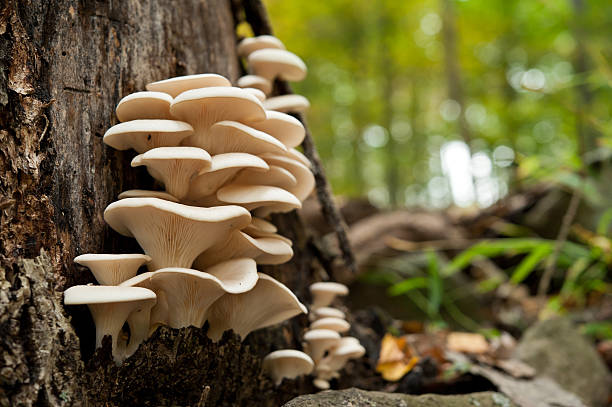
Τα μανιτάρια πλευρώτους διαγράφονται από τις χορτοφαγικές επιλογές, καθώς σκοτώνουν και τρώνε σκουλήκια
Μανιτάρι λέμε το ορατό μέρος πολυκύτταρων μυκήτων, με ομβρελοειδή μορφή. Πρόκειται για το σώμα, ό,τι προκύπτει δηλαδή, από την ανάπτυξη των σποριών.
Το κύριο μέρος του μύκητα είναι υπόγειο -σχεδόν πάντα αθέατο. Λέγεται μυκήλιο.
Γιατί τα λέμε όμως, όλα αυτά;
Μύκητας πλευρώτους μανιταριών χρησιμοποιεί νευρικό αέριο, για να παραλύσει και στη συνέχεια να ρουφήξει τα μικροσκοπικά σκουλήκια (νηματώδη) που το απειλούν -που είναι έτοιμα να αναπτυχθούν πάνω του.
Το αέριο αυτό, λέγεται 3-οκτανόνη.
Το τι κάνει ο συγκεκριμένος μύκητας ήταν γνωστό από το '80. Τώρα έγινε γνωστό και το πώς το κάνει.
Η Yen-Ping Hsueh του ερευνητικού ινστιτούτου Academia Sinica, στην Ταϊβάν και η ομάδα της είχαν ανακαλύψει πως ο μύκητας του πλευρώτους περιέχει μικροσκοπικές δομές, σε σχήμα γλειφιτζουριού. Αυτές ανοίγουν όταν τα νηματώδη σκουλήκια πιέζουν το κεφάλι τους πάνω τους.
Τώρα ανακάλυψαν πως όταν προκληθεί σχισμή, απελευθερώνεται από αυτήν ένα αέριο που είναι πολύ τοξικό για το νευρικό σύστημα των σκουληκιών.
Για την ακρίβεια, προκαλεί μαζική εισροή ιόντων ασβεστίου στα νευρικά και τα μυικά κύτταρα του σώματος, οδηγώντας σε ταχεία παράλυση και θάνατο.
Το φαινόμενο ονομάστηκε “νευρικό αέριο σε γλειφιτζούρι”.

Αφότου σκοτωθεί η λεία, οι δομές αναπτύσσονται γύρω από το σώμα του σκουληκιού, για να το απορροφήσουν “ίσως γιατί έτσι 'λαμβάνουν' άζωτο, στοιχείο που είναι ανεπαρκές στο σάπιο ξύλο όπου αναπτύσσεται ο μύκητας”.
Αν είναι επικίνδυνο και για τους ανθρώπους αυτό το αέριο;
Βρίσκεται στην μακριές διακλαδιζόμενες δομές που αναπτύσσονται μέσα στο σάπιο ξύλο και αποτελούν το μεγαλύτερο μέρος του μύκητα. Αυτά που βλέπουμε, κόβουμε και τρώμε δεν είναι τοξικά.
Το εύρημα ωστόσο, προκαλεί συζήτηση στη vegan κοινότητα, σχετικά με
το εάν τα μανιτάρια πλευρώτους είναι μια πραγματικά vegan τροφή.
______________________
The Toxin That Helps Oyster Mushrooms Devour Worm Flesh
Mushroom kills with cookie cutter trick | New Scientist
________________________
See and listen to this timelapse film in a quiet place where you will not be disturbed. Headphones are highly recommended. Only in silence can we hear the song of nature. This timelapse film about oyster mushrooms was shot in Denmark.
Even though these mushrooms grow fast it still takes about a week from they appear on the forest floor until they reach their full size.
Fungi is a kingdom with about 144,000 known and described species of organisms. But it is estimated that there may be between 2.2 million and 3.8 million total species. They can be single celled or very complex multicellular organisms. The fungi kingdom includes yeasts, rusts, smuts, mildews, molds, and mushrooms. Fungi are among the most widely distributed organisms on Earth and they are of very big environmental and medical importance.MUSHROOMS
Mushrooms are the fruiting bodies that some fungi produce - typically above ground on the soil or on decaying wood or other food sources. Mushrooms vary in size, shape, color, and longevity. Some mushrooms are microscopic and completely invisible to the unaided eye while others are gigantic structures.
The fine threads under-ground that make up the main body of the fungi is called mycelium. The mycelium stretches out beneath the mushroom in search of water and food.
Unlike a plant, a fungus can’t make its own food by using energy from the sun. Instead, the fungus produces enzymes which are released by the mycelium and break down dead plants and animals. This organic matter is then absorbed through the mycelium and used by the fungus for growth.
The mushrooms, because of their size, are easily seen in fields and forests and consequently were the only fungi known before the invention of the microscope.
OYSTER MUSHROOMS
Oyster mushrooms is the common name for the species Pleurotus ostreatus. The funghi normally grow naturally on and near trees in temperate and subtropic forests. They are found around the world including in the UK and Ireland, most of mainland Europe, Asia, and parts of North America. Unlike many fungi, these mushrooms are not seasonal and can be found all year round.
Oyster mushrooms are one of the most widely consumed mushrooms in the world and are grown commercially in many countries. They aren’t just tasty; they can be really healthy to eat. They contain antioxidants and are high in several vitamins and minerals. They even have the potential to lower cholesterol levels, slow the spread of cancer and decrease inflammation in the body.
Oyster mushrooms get their name from their oyster or shell shaped cap that grow in tiers or clusters. They have a very short or non-existent stem. The color is typically light grey or greyish-brown. Oyster mushrooms are medium to large in size with caps averaging from 5 to 25 centimeters in diameter.
Oyster mushrooms use powerful enzymes to break down and eat hardwood. Oyster mushrooms are one of the few carnivorous mushrooms. The mycelia of oyster mushrooms secrete a powerful toxin to stuns passing microscopic nematode, which are small roundworms. The fungi use their sprawling fibers to seek out and enter the mouths of these microscopic nematodes and suck out their guts. This gives the fungi nitrogen for growth.



Δεν υπάρχουν σχόλια:
Δημοσίευση σχολίου